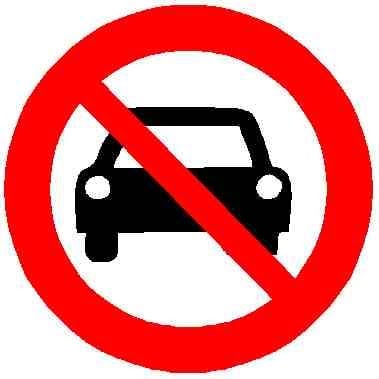The absurdity of the proposal is already in the title, and shows how motonormativity is spread all over the world.
Berlin has a very good public transit system, and a few 30 km/h zones cannot be that bad.
I would love to hear opinions from someone who lives there!
crossposted from: https://mastodon.uno/users/rivoluzioneurbanamobilita/statuses/114732266280428499



I don’t really understand this. Air quality is not affected if it’s electric cars. If it’s about ICE cars - then, in general, efficiency goes up till ~90km/h.
I feel like the limit was lowered for a fake reason and is now suggested to be brought back up for a bad one.
The evidence of studies says that you are wrong.
Here are some key points from a study summary that was made for London: 20mph zones do not appear to worsen air quality and they dramatically reduce road danger. They also support a shift to walking and cycling, generate less traffic noise and reduce community severance. In 20mph zones vehicles move more smoothly with fewer accelerations and decelerations. This driving style produces fewer particulate emissions.
https://content.tfl.gov.uk/speed-emissions-and-health.pdf
Fair enough on the part in bold.
As someone who lives in London, I can say it does come with a caveat - traffic system here are set up by chimpanzees. It makes no sense, none of the three groups - pedestrians, cyclists or drivers - get prioritised. None of the lights are interconnected, so all they bring is annoyance for everyone. I’m an occasional pedestrian, cycling commuter and a (mostly) weekend driver.
TLDR - no wonder the study found that.
The article/slideshow I linked is not a specific scientific study that was done in London, it’s a summary/aggregate of other studies that are referenced at the end of the slideshow. It was a study summary made for London, but the science behind it is a lot more general.
I’m from Belgium and from my own personal experience, I find that well done low speed zones really do improve the flow of traffic. Cities in the Netherlands have been at it for probably over 2 decades, Antwerp has followed their example since about a decade and now other cities in Flanders are copying Antwerp’s homework. When done well, it works really well and almost noone wants to go back to how it used to be. You’re right in that coordinated traffic lights are a big part of why the traffic flows much better, but in congested streets, a lower speed is needed to keep that flow going.
In Belgium we also have a big example of how to not do street renewal/traffic improvement programs: Brussels.
Tire and brake particulate is a real air quality impact that is either worse with EVs (for tire particulate because they are heavier) or mitigated, but still present for EVs (for brake particulate because regenerative braking reduces but does not eliminate the use of physical brake pads). For ICE cars (which are still the dominant form of car when looking at what’s on the road today), efficiency might go up in terms of fuel consumed per mile at a steady speed of 90 kph, but urban driving involves a lot of stopping and going, and reducing the speed limit reduces the amount and intensity of acceleration being done, which is where emissions are going to be worst. Also, the existence of 30 kph zones encourages alternatives to driving, whether that is low-no emission modes like walking, biking, or transit, or moving car trips away from the 30 kph zones to other areas (there’s a potential negative externality to the latter, but if done well, this can move car airborne emissions away from where a lot of people live and play and towards corridors and areas that are designed with uses that are more tolerant to poor outdoor air quality (e.g.: industrial parks, generally lower density areas, etc.)). That’s not to mention road vehicle noise pollution (sometimes considered part of air pollution, but most times not) and safety benefits that come alongside the air quality benefits discussed in this article from having fewer and slower cars
Are you talking about fuel efficiency or total emission though? The efficiency might go up but the emission might still go up, it might be less emission per km/h but maybe not per km.
It’s a direct correlation. Emissions come from fuel burnt. Less fuel - lower emissions.
Are you saying that going to 90km/h emit less than going 30km/h?
No, I’m not.
I’m not trying to be sarcastic here, I genuinely do not understand what you are saying. Please give an example and/or a reference, whichever is more convenient.
Sorry, it’s rare people are not asking for trouble here :)
I mean that any (reasonable) distance travelled at 90km/h will have consumed less fuel than that travelled at 30km/h; given the same car is used, reasonable gear is selected, etc, of course. If there is less fuel consumed, then, naturally, the emissions are lower as well, since that’s just a byproduct of combustion.
While travelling at 90km/h will consume more fuel per unit of time than at 30km/h, the speed increase makes up for that.
Lower speeds reduce road danger
Are extra casualties and reduced freedom for people who aren’t driving worth the few minutes saved for a minority of people?
You’re arguing something else.
As for EV usage, only 80-90% of particulate matter pollution comes from the exhaust of cars. So EVs don’t solve the issue. https://www.oecd.org/en/publications/non-exhaust-particulate-emissions-from-road-transport_4a4dc6ca-en.html
.
In Berlin, only 3% of all registered cars are pure electric cars (numbers from 2024).
Speeds of 30 km/h lower the emissions of nitrogen oxide from cars with combustion engines. This happens because of significant reduction of pollutant-laden acceleration processes.
The reduction of emissions from such a speed limit is based on more uniform traffic flows.
Slow speeds make public transit a little more attractive to people on a time budget.
This is not necessarily the case - it has been shown that slower car speeds in cities leads to better traffic flows and thus can lead to more efficiency of car travel, less traffic jams. So everyone driving slower can lead to more reliability and less average travel duration of cars.
Both of these can be true.